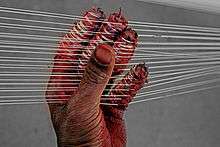Manja (kite)

Manja (or manjha) is an abrasive string used for fighter kites in Afghanistan, Bangladesh, India, Nepal and Pakistan. It is gummed, coloured and coated with powdered glass. In Brazil, the mix of glue and powdered glass is called "cerol". In Chile, the sharp thread is called "hilo curado" (cured thread).
Kites are flown throughout the year during specialized kite flying festivals. Manja is used in competition, where two opponents will entangle the kites in the sky in an attempt to cut their opponent's kites from control by pulling it. The loser's kite will drift away, having been cut off by the winner's string. This causes participants to run after and try to capture it when it falls to the ground, a practice known as kite running.
Recipe
Traditional recipes use rice gluten, tree gums and similar natural ingredients, and the exact recipe is often a closely guarded secret of the individual maker. By contrast this is a modern recipe used by some in Tamil Nadu:
Ingredients
- finely powdered glass[1]
- industrial adhesive such as Vajram
- maida flour (Maidha Movu)
- aluminum oxide, abrasive (known as "sudu movu" in Chennai, looks white in colour)
- zirconia alumina, abrasive (known as "iron powder" in Chennai, looks black in colour)
- colouring
The water is boiled with the addition of vajram, to which is added a paste of maida and finely powdered glass pieces to make a thick colloidal solution and the abrasives are added. The colouring is added, while stirring is continued to make a thick paste without the sedimentation of the glass and abrasives.
Safety and risks
Kite fighting poses a variety of safety issues for participants. In the activity, kite runners gazing at the kite often causes them to lose focus of their surroundings.[2] This can endanger their lives when a loose kite moves away, as they may run onto roads or train tracks without paying attention to oncoming traffic or trains.[2][3] Participants may also run risks by scaling trees and buildings in order to retrieve kites that land there, where they may fall as a result. Fighters often fly the kites from rooftops, which poses additional risks to their safety.[4]
The sale of glass-coated kite wires has been banned in many regions as lacerations can occur upon contact with the string.[5][6] The Chamber of Deputies of Chile enacted a law in 2013 forbidding the use of "hilo curado" by law, with the only exceptions being for professional kite flyers in secured locations for competitive use, using strings coated with silicon powder.[7] In 2010, one report said that the ban on Chinese manja in India did not work to curb its sale.[8]
On 15 August 2016, manja strings killed a motorcyclist and two children looking out of the sunroof of their car.[9] On 7 March 2017, a motorcyclist and his father sustained injuries from manja on a road near Chennai, where the man was cut in the throat by a manja that had strayed. He had died as a result.[10] On 10 October 2018, a female doctor riding her scooter in Pune died painfully due to a gash on her neck caused by kite manja.[11]
Threat to birds
Manja is also dangerous to birds as kites that land in trees do not allow for the strings to break apart easily, causing injuries that have required their rescue on more than one occasion.[12]
At the Uttarayan festival, veterinarians had to repeatedly respond to situations where birds had been injured.[13][14][15][16][17][18]
References
- ↑ Ghai, Rajat (15 Dec 2006). "Manja market flying low!". The Times of India. Archived from the original on 24 June 2015.
- 1 2 Malik, Shahid (10 June 2003). "Pakistan tackles killer kites". BBC. Lahore.
- ↑ TNN (14 Jan 2008). "10-year-old boy dies chasing kite". The Times of India.
- ↑ TNN (16 Jan 2004). "Uttarayan cuts short six lives". The Times of India.
- ↑ "Kite thread claims girl's life, 73 others injured in Jaipur on Sankranti". The Hindu. 14 January 2014.
- ↑ "Two Children Die After Kite String Cut Throats". Retrieved 2016-08-17.
- ↑ Chamber of Deputies of Chile (18 February 2014). "En 2013 se publicó ley que sanciona comercialización del hilo curado" [In 2013, a law was published that sanctions the marketing of cured wire].
- ↑ Manish, Kumar (6 January 2010). "Banned Chinese manja still on sale". Times of India.
- ↑ "India: Two children, man dead after sharp kite strings slit throats". Retrieved 2016-08-21.
- ↑ Express News Service (8 March 2017). "Manja kite thread slits 40-yr-old techie throat in Chennai". The New Indian Express. Retrieved 7 May 2017.
- ↑ HT Correspondent (10 October 2018). "Throat slit by manja, doctor lay bleeding on Pune road for 20 minutes". Hindustan Times. Retrieved 11 October 2018.
- ↑ "Chinese manja injures nearly half a dozen birds since January 1". The Times of India. 6 January 2013.
- ↑ Sharma, Radha (5 Jan 2006). "Vets to heal birds this Uttarayan". The Times of India.
- ↑ TNN (14 Jan 2007). "Vulture worries stalk activists on Uttarayan". The Times of India. Archived from the original on 19 Oct 2012.
- ↑ Sharma, Radha (10 Jan 2008). "Docs flock to save winged victims". Times of India.
- ↑ TNN (15 Jan 2005). "Soaring kites ground at least 600 winged souls". The Times of India.
- ↑ Nigam, Jhumari (12 Jan 2004). "Celebrate... but with compassion". The Times of India.
- ↑ TNN (15 Jan 2003). "Many birds fall prey as kites rule skies". The Times of India.